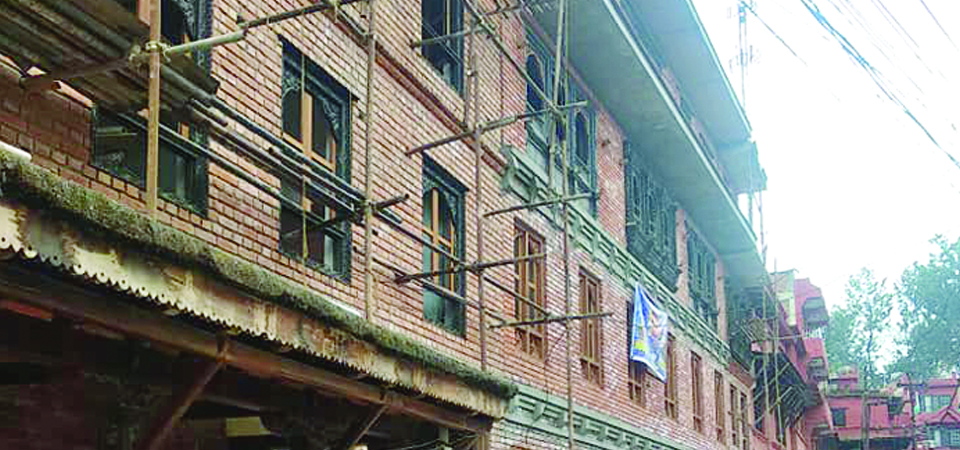Kirtipur locals brace to restore long-lost Layaku Durbar

By Shaurya Kshatri
Kirtipur, Jan. 3: Where once stood the fabled Layaku Durbar or the Royal Palace of Kirtipur, today stand a rows of residential brick houses. The age-old structure, which historians trace back to the supposed founder of Kirtipur, King Shiva Dev back in the 11th century, survives only in folk tales and oral history.
Rupak Maharjan, President of Kirtipur Guide Association, has only ever heard of the Layaku Durbar from elders. “There isn’t a single trace of the said royal residence. Even during my grandfather’s time, only the ruins remained of the palace surrounded by dilapidated boundary walls,” informs Maharjan pointing out to the spot just a little ahead of Newa Lahana en-route to the historic shrine of Uma-Maheswar.
Even the boundaries mentioned by Maharjan’s elders have long gone.
However, a view of what it might have looked like is captured in a water-colour painting by Henry Ambrose Oldfield, a Residency Surgeon at Kathmandu from 1850-1863. The painting, dated 1855, provides a window to the past, which depicts a sombre state of Kirtipur’s Layaku Tole. The Uma-Maheshwar temple perched atop a small conical hill lies in ruins overlooking the destruction below. On the right-hand side of the painting is what appears to be a decrepit boundary wall, which in fact is the last remaining vestige of the long-lost Layaku Durbar.
Artist Henry himself wrote about the Durbar in 'Sketches from Nipal, Historical and Descriptive...' (1880): “In its best estate the durbar was never a large one, but it is now so utterly in ruins that even its form and extent cannot be traced.”
Considering Henry’s account, the Durbar was already wiped off the face of history back in 1855. It is believed that the ruins witnessed by Henry were actually the result of the 18th Century Kirtipur Battle.
According to a handwritten inscription dated 886 Nepal Sambat (1767 A.D.) provided by Bhagwat Pradhan, a Thamel resident, the army led by King Prithvi Narayan Shah wreaked havoc on Kirtipur. The inscription explicitly mentions legions of the victorious Gorkha army burning houses of the local residents and the “Kirtipur Fort.”
“That Kirtipur Fort mentioned in the inscription is in fact the lost Layaku Durbar,” claims Shree Krishna Maharjan, of the Metro FM 94.6 MHz.
Destroyed since the 18th Century, Kirtipur residents have finally woken up to the historical and cultural importance of the lost Layaku Durbar.
As part of the Kirtipur Punarjagaran Abhiyan (Kirtipur Revival Campaign), the Kirtipur Municipality has placed preservation of historical and cultural monuments as a top priority. Despite being rich in cultural and historical heritage, and architectural grandeur, the hitherto unsullied Kirtipur has yet to be enlisted in the coveted UNESCO World Heritage Site.
Modern buildings have sprung up in place of authentic Mallakalin (from Malla dynasty) designs, and modern windows have replaced the traditional aankhijhyals.
Bearing this in mind, on November 29, the Municipal office circulated a notice, urging the denizens to provide any known evidence pertaining to the history and existence of the bygone palace. “The response was overwhelming,” informs Deputy Mayor Saraswati Khadka, stating that they received a total of 1000 signatures from inhabitants in favour of restoring the Layaku Durbar. “We aren’t going to begin construction quite yet. This is just an initial process to know about the lost Royal palace,” adds Khadka.
Talking about the signature campaign, Shree Krishna Maharjan, who is one of the prominent campaigners in the recent initiative to revive the Layakur Durbar, is ecstatic for being able to gather a substantial amount of inscriptions, historic texts, and old photographs and paintings -- all providing conclusive evidence of the Layaku Durbar.
The evidence collected also reveals the names of the people who first began building houses in the ruins of the old palace. Some even claim that the houses built in Kirtipur were made from the ruins of the old Durbar.
“On a positive note, though, residents who today reside at the place where Layakur Durbar once stood, have agreed to vacate the premises if the Municipal office allocates proper shelters for them,” as per Maharjan.
The Layaku Revival campaigners have also submitted a detailed report to the Municipality including all the evidence related to Layaku Durbar with further plans to restore the palace to its former glory and establish it as a museum.
Recent News

Do not make expressions casting dout on election: EC
14 Apr, 2022
CM Bhatta says may New Year 2079 BS inspire positive thinking
14 Apr, 2022
Three new cases, 44 recoveries in 24 hours
14 Apr, 2022
689 climbers of 84 teams so far acquire permits for climbing various peaks this spring season
14 Apr, 2022
How the rising cost of living crisis is impacting Nepal
14 Apr, 2022
US military confirms an interstellar meteor collided with Earth
14 Apr, 2022
Valneva Covid vaccine approved for use in UK
14 Apr, 2022
Chair Prachanda highlights need of unity among Maoist, Communist forces
14 Apr, 2022
Ranbir Kapoor and Alia Bhatt: Bollywood toasts star couple on wedding
14 Apr, 2022
President Bhandari confers decorations (Photo Feature)
14 Apr, 2022










